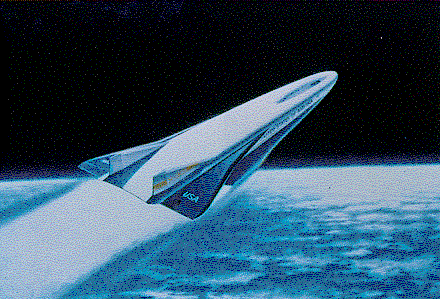 |
|||||
| Home | Research | For Teachers | HISTORY Level 1 Level 2 Level 3 |
PRINCIPLES Level 1 Level 2 Level 3 |
CAREER Level 1 Level 2 Level 3 |
| Gallery | Hot Links | What's New! | |||
| Web Administration and Tools | |||||
 |
|||||
| Home | Research | For Teachers | HISTORY Level 1 Level 2 Level 3 |
PRINCIPLES Level 1 Level 2 Level 3 |
CAREER Level 1 Level 2 Level 3 |
| Gallery | Hot Links | What's New! | |||
| Web Administration and Tools | |||||
![]()
An important part of NASA's aeronautical research involves development of
technology for future vehicles capable of airbreathing hypersonic flight, which by
definition is flight faster than Mach 5, or five times the speed of sound (about 3300
miles per hour).
Over the past decade, NASA has conducted several hypersonic exploratory investigations and
built a technology base in such areas as hypersonic propulsion, cryogenic fuel, materials
and structures, computer science, and integration of engines with hypersonic airframes. A
technology of particular interest is the scramjet (supersonic combustion ramjet)
propulsion system, which burns a mix of hydrogen carried aboard the vehicle and oxygen
scooped up from the atmosphere.
In 1997, NASA will initiate a new effort to advance hypersonic technology for airbreathing
vehicles. Called Hypersonic XVehicle (Hyper-X), it is a technology development program
intended to further expand the knowledge base in this area of aeronautics. Successful
development of the essential technologies would afford potential for future application in
global reach military aircraft or, in space operations, as the first stage of a two
stage-to-orbit vehicle.
Preliminary design, analysis and wind tunnel work was conducted in 1995-96. The program
contemplates a five-year effort, beginning in Fiscal Year 1997, involving wind tunnel and
flight tests of a subscale, unmanned experimental airframe powered by an airframe embedded
scramjet engine. Flight tests, to begin in 1998, will be conducted at specified test
points up to Mach 10.

One possible configuration of a future airbreathing hypersonic vehicle
that couldcruise within the atmosphereat speeds up to Mach 10.
Visit our Video Gallery for
streaming videos on the Hyper-X vehicle.
![]()
Send all comments to ![]() aeromaster@eng.fiu.edu
aeromaster@eng.fiu.edu
© 1995-98 ALLSTAR Network. All rights reserved worldwide.
Updated: February 17, 1999